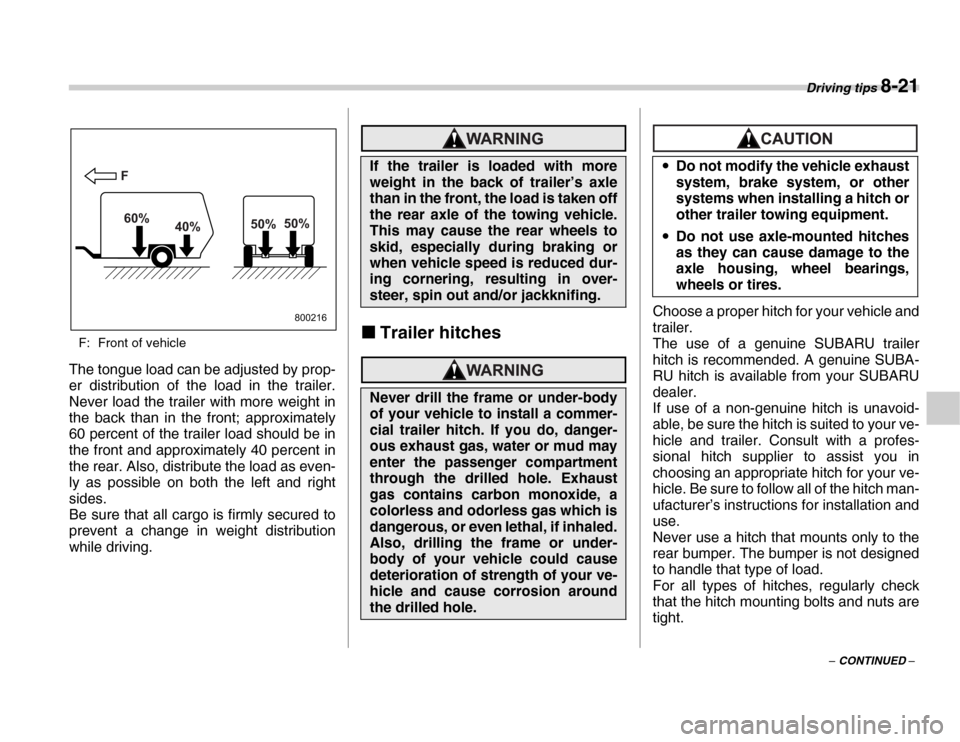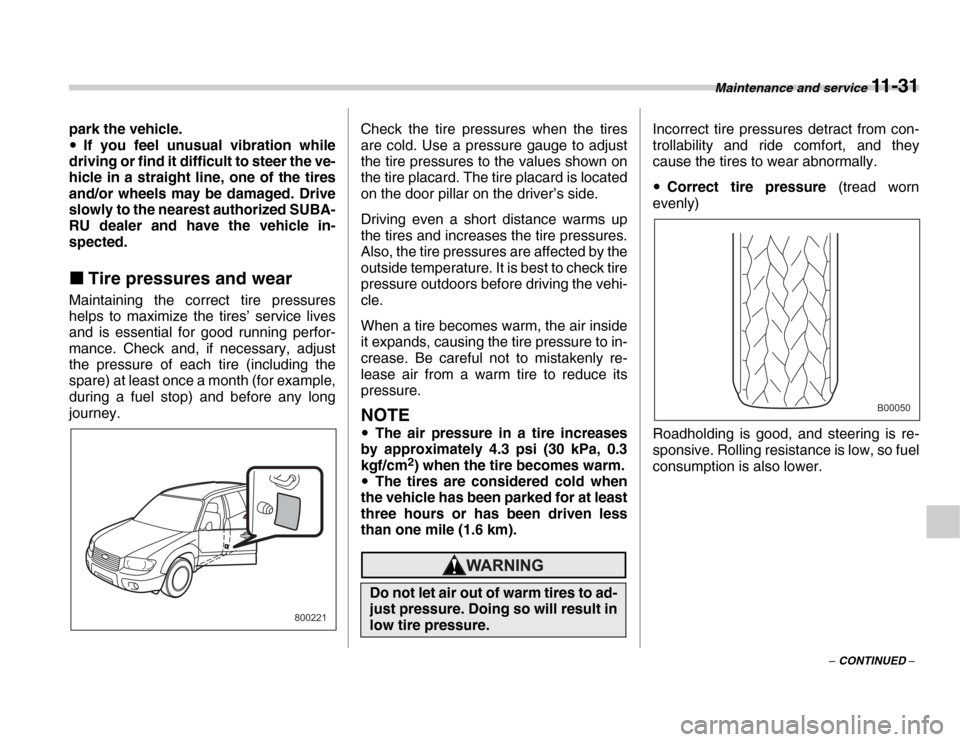2007 SUBARU FORESTER tires
[x] Cancel search: tiresPage 245 of 356

Driving tips 8-21
– CONTINUED –
F: Front of vehicle
The tongue load can be adjusted by prop-
er distribution of the load in the trailer.
Never load the trailer with more weight in
the back than in the front; approximately
60 percent of the trailer load should be in
the front and approximately 40 percent in
the rear. Also, distribute the load as even-
ly as possible on both the left and right
sides.
Be sure that all cargo is firmly secured to
prevent a change in weight distribution
while driving.
�„ Trailer hitches
Choose a proper hitch for your vehicle and
trailer.
The use of a genuine SUBARU trailer
hitch is recommended. A genuine SUBA-
RU hitch is available from your SUBARU
dealer.
If use of a non-genuine hitch is unavoid-
able, be sure the hitch is suited to your ve-
hicle and trailer. Consult with a profes-
sional hitch supplier to assist you in
choosing an appropriate hitch for your ve-
hicle. Be sure to follow all of the hitch man-
ufacturer’s instructions for installation and
use.
Never use a hitch that mounts only to the
rear bumper. The bumper is not designed
to handle that type of load.
For all types of hitches, regularly check
that the hitch mounting bolts and nuts are
tight.
F
60% 40% 50%
50%
800216
If the trailer is loaded with more
weight in the back of trailer’s axle
than in the front, the load is taken off
the rear axle of the towing vehicle.
This may cause the rear wheels to
skid, especially during braking or
when vehicle speed is reduced dur-
ing cornering, resulting in over-
steer, spin out and/or jackknifing.
Never drill the frame or under-body
of your vehicle to install a commer-
cial trailer hitch. If you do, danger-
ous exhaust gas, water or mud may
enter the passenger compartment
through the drilled hole. Exhaust
gas contains carbon monoxide, a
colorless and odorless gas which is
dangerous, or even lethal, if inhaled.
Also, drilling the frame or under-
body of your vehicle could cause
deterioration of strength of your ve-
hicle and cause corrosion around
the drilled hole.
�y
Do not modify the vehicle exhaust
system, brake system, or other
systems when installing a hitch or
other trailer towing equipment.
�y Do not use axle-mounted hitches
as they can cause damage to the
axle housing, wheel bearings,
wheels or tires.
Page 247 of 356

Driving tips 8-23
– CONTINUED –
Connection of trailer lights to your vehi-
cle’s electrical system requires modifica-
tions to the vehicle’s lighting circuit to in-
crease its capacity and accommodate wir-
ing changes. To ensure the trailer lights
are connected properly, please consult
your SUBARU dealer. Check for proper
operation of the turn signals, the brake
lights and parking lights each time you
hitch up. �T
Tires
Make sure that all the tires on your vehicle
are properly inflated to the pressure spec-
ified on the tire placard located on the driv-
er’s side center pillar.
Trailer tire condition, size, load rating and
proper inflation pressure should be in ac-
cordance with the trailer manufacturer’s
specifications. �„
Trailer towing tips
�TBefore starting out on a trip
�y Check that the vehicle and vehicle-to-
hitch mounting are in good condition. If
any problems are apparent, do not tow the
trailer. �y Check that the vehicle sits horizontally
with the trailer attached. If the vehicle is
tipped sharply up at the front and down at
the rear, check the total trailer weight,
GVW, GAWs and tongue load again, then
confirm that the load and its distribution
are acceptable. �y Check that the tire pressures are cor-
rect. �y Check that the vehicle and trailer are connected properly. Confirm that
– the trailer tongue is connected prop-
erly to the hitch ball.
– the trailer lights connector is connect-
ed properly and trailer’s brake lights illu-
minate when the vehicle’s brake pedal
is pressed, and that the trailer’s turn sig-
nal lights flash when the vehicle’s turn
signal lever is operated.
– the safety chains are connected prop-
erly.
– all cargo in the trailer is secured safe-
ty in position.
– the side mirrors provide a good rear-
ward field of view without a significant
blind spot.
�y Sufficient time should be taken to learn
the “feel” of the vehicle/trailer combination
before starting out on a trip. In an area free
of traffic, practice turning, stopping and
backing up. �T Driving with a trailer
�y You should allow for considerably more
stopping distance when towing a trailer.
Avoid sudden braking because it may re-
sult in skidding or jackknifing and loss of
control. �y Avoid abrupt starts and sudden acceler-
ations. If your vehicle has a manual trans-
mission, always start out in first gear and
release the clutch at moderate engine rev-
Never tow a trailer when the tempo-
rary spare tire is used. The tempo-
rary spare tire is not designed to
sustain the towing load. Use of the
temporary spare tire when towing
can result in failure of the spare tire
and/or less stability of the vehicle.
�y Never exceed 45 mph (72 km/h)
when towing a trailer in hilly coun-
try on hot days.
�y When towing a trailer, steering,
stability, stopping distance and
braking performance will be dif-
ferent from normal operation. For
safety’s sake, you should employ
extra caution when towing a trail-
er and you should never speed.
You should also keep the follow-
ing tips in mind:
Page 251 of 356

9
In case of emergency
If you park your vehicle in case of an emergency .................................................. 9-2
Temporary spare tire (if equipped) ................... 9-2
Flat tires .............................................................. 9-3 Changing a flat tire ................................................. 9-3
Jump starting ...................................................... 9-7 How to jump start ................................................... 9-8
Engine overheating ............................................ 9-10 If steam is coming from the engine compartment ......................................................... 9-10
If no steam is coming from the engine compartment ......................................................... 9-10
Towing ................................................................. 9-10 Towing and tie-down hooks .................................. 9-11
Using a flat-bed truck ............................................. 9-12
Towing with all wheels on the ground .................. 9-12
Rear gate – if the rear gate cannot be unlocked .......................................................... 9-13
Moonroof – if the moonroof cannot be closed ............................................................... 9-13
Maintenance tools .............................................. 9-14 Jack and jack handle .............................................. 9-14
Page 253 of 356

In case of emergency 9-3
– CONTINUED –
ready for use. The correct pressure is
60
psi (420 kPa, 4.2 kg/cm 2
).
When using the temporary spare tire, note
the following. �y Do not exceed 50 mph (80 km/h).
�y Do not put a tire chain on the temporary
spare tire. Because of the smaller tire
size, a tire chain will not fit properly. �y Do not use two or more temporary
spare tires at the same time. �y Do not drive over obstacles. This tire
has a smaller diameter, so road clearance
is reduced.
1) Tread wear indicator bar
2) Indicator location mark
�y When the wear indicator appears on the
tread, replace the tire. 1) Spare fuse
2) FWD connector
NOTE
(All AWD AT models) Before driving
your vehicle with the temporary spare
tire, put a spare fuse inside the FWD
connector in the main fuse box located
in the engine compartment and con-
firm that the Front-wheel drive warning
light “AWD” in the combination meter
comes on. The all wheel drive capabili-
ty of the vehicle has now deactivated.
After re-installing the conventional tire,
remove the spare fuse from the FWD
connector in order to reactivate all
wheel drive.
Flat tires
If you have a flat tire while driving, never
brake suddenly; keep driving straight
ahead while gradually reducing speed.
Then slowly pull off the road to a safe
place. �„ Changing a flat tire
900231
1
2
1
2
600435
�y Do not jack up the vehicle on an
incline or a loose road surface.
The jack can come out of the jack-
ing point or sink into the ground
and this can result in a severe ac-
cident.
�yUse only the jack provided with
your vehicle. The jack supplied
with the vehicle is designed only
for changing a tire. Never get un-
der the vehicle while supporting
the vehicle with this jack.
Page 265 of 356

In case of emergency 9-15
For how to use the jack, refer to the “Flat
tires” section in this chapter.
Page 274 of 356

Maintenance and service
Replacement of brake pad and lining ............... 11-29Breaking-in of new brake pads and linings ......... 11-29
Parking brake stroke .......................................... 11-30
Tires and wheels ................................................ 11-30 Types of tires .......................................................... 11-30
Tire inspection ........................................................ 11-30
Tire pressures and wear ........................................ 11-31
Wheel balance ........................................................ 11-32
Wear indicators ....................................................... 11-33
Tire rotation direction mark ................................... 11-33
Tire rotation ............................................................. 11-33
Tire replacement ..................................................... 11-34
Wheel replacement ................................................. 11-35
Aluminum wheels (if equipped) ........................ 11-35
Windshield washer fluid .................................... 11-35
Replacement of wiper blades ............................ 11-37 Windshield wiper blades ........................................ 11-37
Rear window wiper blade ....................................... 11-38
Battery ................................................................. 11-40
Fuses ................................................................... 11-41
Main fuse ............................................................. 11-42
Installation of accessories ................................ 11-43
Replacing bulbs .................................................. 11-44 Headlights (Canada-spec. 2.5XT) .......................... 11-45
Headlights (Except Canada-spec. 2.5XT) ............. 11-46
Rear combination lights ......................................... 11-47
License plate light .................................................. 11-48
Dome light and map light ....................................... 11-48
High mount stop light ............................................ 11-49
Page 302 of 356

11 - 3 0 Maintenance and service
Parking brake stroke
Check the parking brake stroke according
to the maintenance schedule in the “War-
ranty and Maintenance Booklet”. When
the parking brake is properly adjusted,
braking power is fully applied by pulling
the lever up seven to eight notches gently
but firmly (approximately 44 lbs, 196 N, 20
kg). If the parking brake lever stroke is not
within the specified range, have the brake
system checked and adjusted at your
SUBARU dealer.Tires and wheels �„Types of tires
You should be familiar with type of tires
present on your vehicle. �T All season tires
The factory-installed tires on your new ve-
hicle are all season tires.
All season tires are designed to provide
an adequate measure of traction, handling
and braking performance in year-round
driving including snowy and icy road con-
ditions. However all season tires do not of-
fer as much traction performance as win-
ter (snow) tires in heavy or loose snow or
on icy roads.
All season tires are identified by “ALL
SEASON” and/or “M+S” (Mud & Snow) on
the tire sidewall. �T Summer tires
Summer tires are high-speed capability
tires best suited for highway driving under
dry conditions.
Summer tires are inadequate for driving
on slippery roads such as on snow-cov-
ered or icy roads.
If you drive your vehicle on snow-covered
or icy roads, we strongly recommend the
use of winter (snow) tires.
When installing winter tires, be sure to re- place all four tires. �T
Winter (snow) tires
Winter tires are best suited for driving on
snow-covered and icy roads. However
winter tires do not perform as well as sum-
mer tires and all season tires on roads oth-
er than snow-covered and icy roads.
�„ Tire inspection
Check on a daily basis that the tires are
free from serious damage, nails, and
stones. At the same time, check the tires
for abnormal wear.
Contact your SUBARU dealer immediate-
ly if you find any problem.
NOTE �y When the wheels and tires strike
curbs or are subjected to harsh treat-
ment as when the vehicle is driven on a
rough surface, they can suffer damage
that cannot be seen with the naked eye.
This type of damage does not become
evident until time has passed. Try not
to drive over curbs, potholes or on oth-
er rough surfaces. If doing so is un-
avoidable, keep the vehicle’s speed
down to a walking pace or less, and ap-
proach the curbs as squarely as possi-
ble. Also, make sure the tires are not
pressed against the curb when you
B00379
Page 303 of 356

Maintenance and service 11 - 31
– CONTINUED –
park the vehicle. �y
If you feel unusual vibration while
driving or find it difficult to steer the ve-
hicle in a straight line, one of the tires
and/or wheels may be damaged. Drive
slowly to the nearest authorized SUBA-
RU dealer and have the vehicle in-
spected. �„ Tire pressures and wear
Maintaining the correct tire pressures
helps to maximize the tires’ service lives
and is essential for good running perfor-
mance. Check and, if necessary, adjust
the pressure of each tire (including the
spare) at least once a month (for example,
during a fuel stop) and before any long
journey. Check the tire pressures when the tires
are cold. Use a pressure gauge to adjust
the tire pressures to the values shown on
the tire placard. The tire placard is located
on the door pillar on the driver’s side.
Driving even a short distance warms up
the tires and increases the tire pressures.
Also, the tire pressures are affected by the
outside temperature. It is best to check tire
pressure outdoors before driving the vehi-
cle.
When a tire becomes warm, the air inside
it expands, causing the tire pressure to in-
crease. Be careful not to mistakenly re-
lease air from a warm tire to reduce its
pressure.
NOTE
�y The air pressure in a tire increases
by approximately 4.3 psi (30 kPa, 0.3
kgf/cm 2
) when the tire becomes warm.
�y The tires are considered cold when
the vehicle has been parked for at least
three hours or has been driven less
than one mile (1.6 km).
Incorrect tire pressures detract from con-
trollability and ride comfort, and they
cause the tires to wear abnormally. �y Correct tire pressure (tread worn
evenly)
Roadholding is good, and steering is re-
sponsive. Rolling resistance is low, so fuel
consumption is also lower.
800221
Do not let air out of warm tires to ad-
just pressure. Doing so will result in
low tire pressure.
B00050